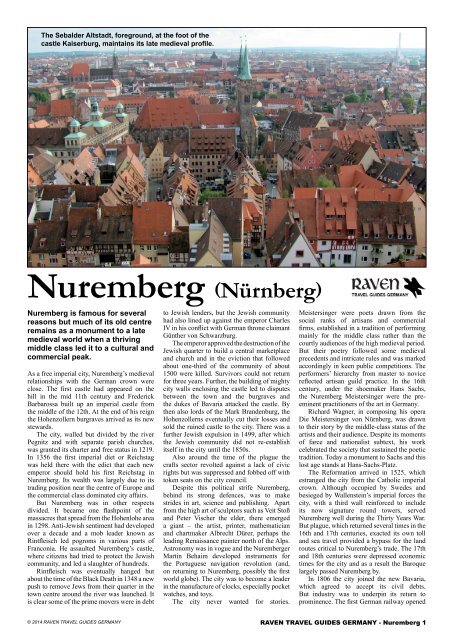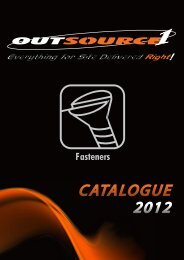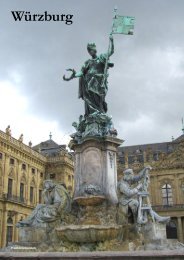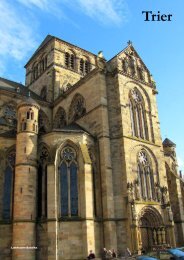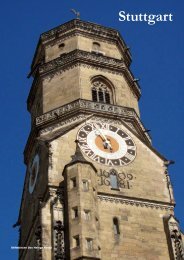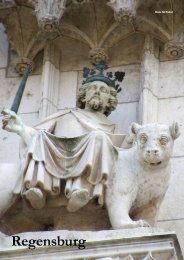Raven Guides: Germany - Nuremberg
Create successful ePaper yourself
Turn your PDF publications into a flip-book with our unique Google optimized e-Paper software.
The Sebalder Altstadt, foreground, at the foot of the<br />
castle Kaiserburg, maintains its late medieval profile.<br />
<strong>Nuremberg</strong> (Nürnberg)<br />
<strong>Nuremberg</strong> is famous for several<br />
reasons but much of its old centre<br />
remains as a monument to a late<br />
medieval world when a thriving<br />
middle class led it to a cultural and<br />
commercial peak.<br />
As a free imperial city, <strong>Nuremberg</strong>’s medieval<br />
relationships with the German crown were<br />
close. The first castle had appeared on the<br />
hill in the mid 11th century and Frederick<br />
Barbarossa built up an imperial castle from<br />
the middle of the 12th. At the end of his reign<br />
the Hohenzollern burgraves arrived as its new<br />
stewards.<br />
The city, walled but divided by the river<br />
Pegnitz and with separate parish churches,<br />
was granted its charter and free status in 1219.<br />
In 1356 the first imperial diet or Reichstag<br />
was held there with the edict that each new<br />
emperor should hold his first Reichstag in<br />
<strong>Nuremberg</strong>. Its wealth was largely due to its<br />
trading position near the centre of Europe and<br />
the commercial class dominated city affairs.<br />
But <strong>Nuremberg</strong> was in other respects<br />
divided. It became one flashpoint of the<br />
massacres that spread from the Hohenlohe area<br />
in 1298. Anti-Jewish sentiment had developed<br />
over a decade and a mob leader known as<br />
Rintfleisch led pogroms in various parts of<br />
Franconia. He assaulted <strong>Nuremberg</strong>’s castle,<br />
where citizens had tried to protect the Jewish<br />
community, and led a slaughter of hundreds.<br />
Rintfleisch was eventually hanged but<br />
about the time of the Black Death in 1348 a new<br />
push to remove Jews from their quarter in the<br />
town centre around the river was launched. It<br />
is clear some of the prime movers were in debt<br />
to Jewish lenders, but the Jewish community<br />
had also lined up against the emperor Charles<br />
IV in his conflict with German throne claimant<br />
Günther von Schwarzburg.<br />
The emperor approved the destruction of the<br />
Jewish quarter to build a central marketplace<br />
and church and in the eviction that followed<br />
about one-third of the community of about<br />
1500 were killed. Survivors could not return<br />
for three years. Further, the building of mighty<br />
city walls enclosing the castle led to disputes<br />
between the town and the burgraves and<br />
the dukes of Bavaria attacked the castle. By<br />
then also lords of the Mark Brandenburg, the<br />
Hohenzollerns eventually cut their losses and<br />
sold the ruined castle to the city. There was a<br />
further Jewish expulsion in 1499, after which<br />
the Jewish community did not re-establish<br />
itself in the city until the 1850s.<br />
Also around the time of the plague the<br />
crafts sector revolted against a lack of civic<br />
rights but was suppressed and fobbed off with<br />
token seats on the city council.<br />
Despite this political strife <strong>Nuremberg</strong>,<br />
behind its strong defences, was to make<br />
strides in art, science and publishing. Apart<br />
from the high art of sculptors such as Veit Stoß<br />
and Peter Vischer the elder, there emerged<br />
a giant – the artist, printer, mathematician<br />
and chartmaker Albrecht Dürer, perhaps the<br />
leading Renaissance painter north of the Alps.<br />
Astronomy was in vogue and the <strong>Nuremberg</strong>er<br />
Martin Behaim developed instruments for<br />
the Portuguese navigation revolution (and,<br />
on returning to <strong>Nuremberg</strong>, possibly the first<br />
world globe). The city was to become a leader<br />
in the manufacture of clocks, especially pocket<br />
watches, and toys.<br />
The city never wanted for stories.<br />
Meistersinger were poets drawn from the<br />
social ranks of artisans and commercial<br />
firms, established in a tradition of performing<br />
mainly for the middle class rather than the<br />
courtly audiences of the high medieval period.<br />
But their poetry followed some medieval<br />
precedents and intricate rules and was marked<br />
accordingly in keen public competitions. The<br />
performers’ hierarchy from master to novice<br />
reflected artisan guild practice. In the 16th<br />
century, under the shoemaker Hans Sachs,<br />
the <strong>Nuremberg</strong> Meistersinger were the preeminent<br />
practitioners of the art in <strong>Germany</strong>.<br />
Richard Wagner, in composing his opera<br />
Die Meistersinger von Nürnberg, was drawn<br />
to their story by the middle-class status of the<br />
artists and their audience. Despite its moments<br />
of farce and nationalist subtext, his work<br />
celebrated the society that sustained the poetic<br />
tradition. Today a monument to Sachs and this<br />
lost age stands at Hans-Sachs-Platz.<br />
The Reformation arrived in 1525, which<br />
estranged the city from the Catholic imperial<br />
crown. Although occupied by Swedes and<br />
besieged by Wallenstein’s imperial forces the<br />
city, with a third wall reinforced to include<br />
its now signature round towers, served<br />
<strong>Nuremberg</strong> well during the Thirty Years War.<br />
But plague, which returned several times in the<br />
16th and 17th centuries, exacted its own toll<br />
and sea travel provided a bypass for the land<br />
routes critical to <strong>Nuremberg</strong>’s trade. The 17th<br />
and 18th centuries were depressed economic<br />
times for the city and as a result the Baroque<br />
largely passed <strong>Nuremberg</strong> by.<br />
In 1806 the city joined the new Bavaria,<br />
which agreed to accept its civil debts.<br />
But industry was to underpin its return to<br />
prominence. The first German railway opened<br />
© 2014 RAVEN TRAVEL GUIDES GERMANY<br />
RAVEN TRAVEL GUIDES GERMANY - <strong>Nuremberg</strong> 1


